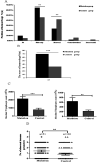Chronic Refractory Immune Thrombocytopenia Is Associated With Variants in Immune Genes
- PMID: 34786962
- PMCID: PMC8619729
- DOI: 10.1177/10760296211059813
Chronic Refractory Immune Thrombocytopenia Is Associated With Variants in Immune Genes
Abstract
The pathogenesis of chronic refractory immune thrombocytopenia (C/RITP) is mechanistically complex and considerably varies across patients. Few studies have focused on the genetic characteristics of C/RITP in children. The aim of this study was to analyze and summarize the clinical manifestations and genetic characteristics of C/RITP children with mutations in immune-related genes. In the study, 51 children with variants in immune-related genes (mutation group) and 103 children with no abnormal mutations (control group) were enrolled. Children in the mutation group showed severity of hemorrhage, a higher incidence of abnormal immunological indices, and an increased expression of SLE biomarkers. The number of peripheral T and B lymphocytes in the mutation group significantly increased. Nine patients (17.6%) had probable pathogenic variant genes associated with primary immunodeficiencies (TNFRSF13B, CARD11, CBL, and RAG2), and 42 patients (82.4%) had variants of uncertain significance in 23 genes. C/RITP patients with variants in immune-related genes had more severe bleeding, abnormal immunological indices, and an increased expression of SLE biomarker. Next-generation sequenciong (NGS) might be a useful way to differentiate those patients from C/RITP.
Keywords: chronic refractory immune thrombocytopenia; immune genes; mutation; next-generation sequencing.
Conflict of interest statement
Figures
Similar articles
-
Recurrent idiopathic thrombocytopenic purpura in childhood.Pediatr Blood Cancer. 2008 Aug;51(2):261-4. doi: 10.1002/pbc.21569. Pediatr Blood Cancer. 2008. PMID: 18421719
-
Screening for Genetic Mutations for the Early Diagnosis of Common Variable Immunodeficiency in Children With Refractory Immune Thrombocytopenia: A Retrospective Data Analysis From a Tertiary Children's Center.Front Pediatr. 2020 Dec 3;8:595135. doi: 10.3389/fped.2020.595135. eCollection 2020. Front Pediatr. 2020. PMID: 33425813 Free PMC article.
-
The role of genetics in refractory immune thrombocytopenia.Br J Haematol. 2023 Oct;203(1):62-64. doi: 10.1111/bjh.19110. Br J Haematol. 2023. PMID: 37735556 Review.
-
Efficacy of standard dose rituximab for refractory idiopathic thrombocytopenic purpura in children.Eur Rev Med Pharmacol Sci. 2015 Jul;19(13):2379-83. Eur Rev Med Pharmacol Sci. 2015. PMID: 26214772
-
Multiple total hip arthroplasties in refractory immune thrombocytopenic purpura: A case report and literature review.Medicine (Baltimore). 2018 Apr;97(15):e0308. doi: 10.1097/MD.0000000000010308. Medicine (Baltimore). 2018. PMID: 29642159 Free PMC article. Review.
Cited by
-
Refractory immune thrombocytopenia: Lessons from immune dysregulation disorders.Front Med (Lausanne). 2022 Sep 20;9:986260. doi: 10.3389/fmed.2022.986260. eCollection 2022. Front Med (Lausanne). 2022. PMID: 36203772 Free PMC article. No abstract available.
-
Novel Biomarkers for Diagnosis and Monitoring of Immune Thrombocytopenia.Int J Mol Sci. 2023 Feb 23;24(5):4438. doi: 10.3390/ijms24054438. Int J Mol Sci. 2023. PMID: 36901864 Free PMC article. Review.
-
Immune thrombocytopenia in adolescents and young adults.Front Med (Lausanne). 2025 Mar 26;12:1553936. doi: 10.3389/fmed.2025.1553936. eCollection 2025. Front Med (Lausanne). 2025. PMID: 40206467 Free PMC article. Review.
References
-
- Imbach P, Kuhne T, Muller D, et al.. Childhood ITP: 12 months follow-up data from the prospective registry I of the intercontinental childhood ITP study group (ICIS). Pediatr Blood Cancer. 2006;46(3):351-356. - PubMed
-
- Heitink-P KM, Nijsten J, Boonacker CW, et al.. Clinical and laboratory predictors of chronic immune thrombocytopenia in children: a systematic review and meta-analysis. Blood. 2014;124(22):3295-3307. - PubMed
-
- Heitink-P KM, Uiterwaal CSPM, Porcelijin L, et al.. Intravenous immunoglobulin versus observation in childhood immune thrombocytopenia: a randomized controlled trial. Blood. 2018;132(9):883-891. - PubMed
-
- Hu Y, Li H, Zhang L, et al.. Elevated profiles of Th22 cells and correlations with Th17 cells in patients with immune thrombocytopenia. Hum Immunol. 2012;73(6):629-635. - PubMed
MeSH terms
LinkOut - more resources
Full Text Sources
Medical
Miscellaneous



